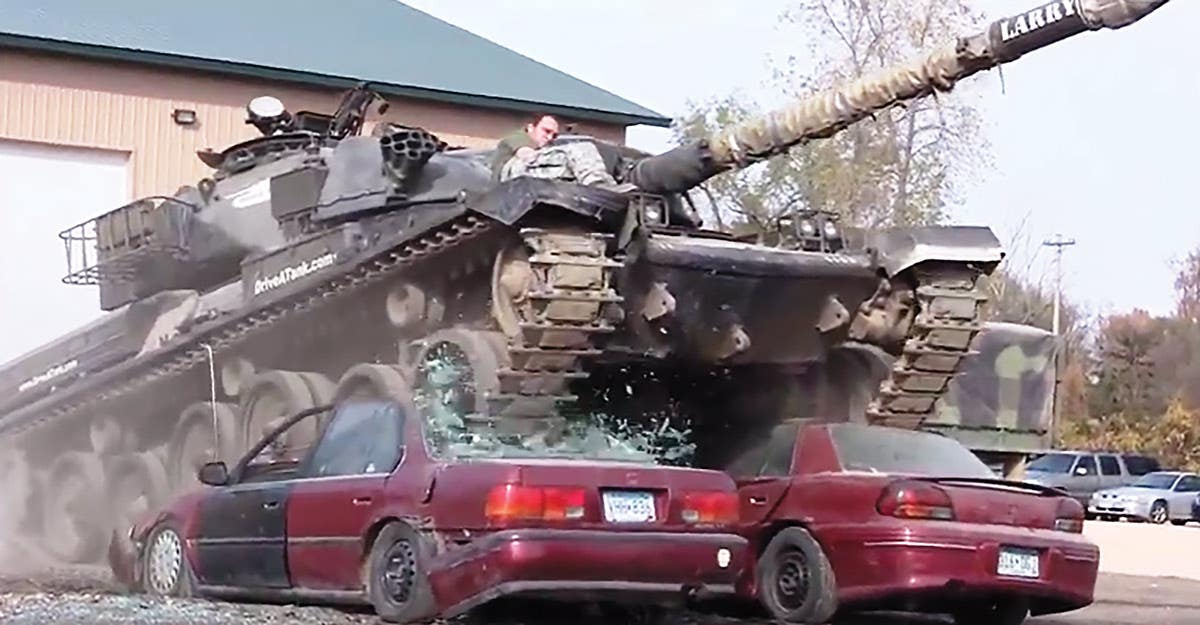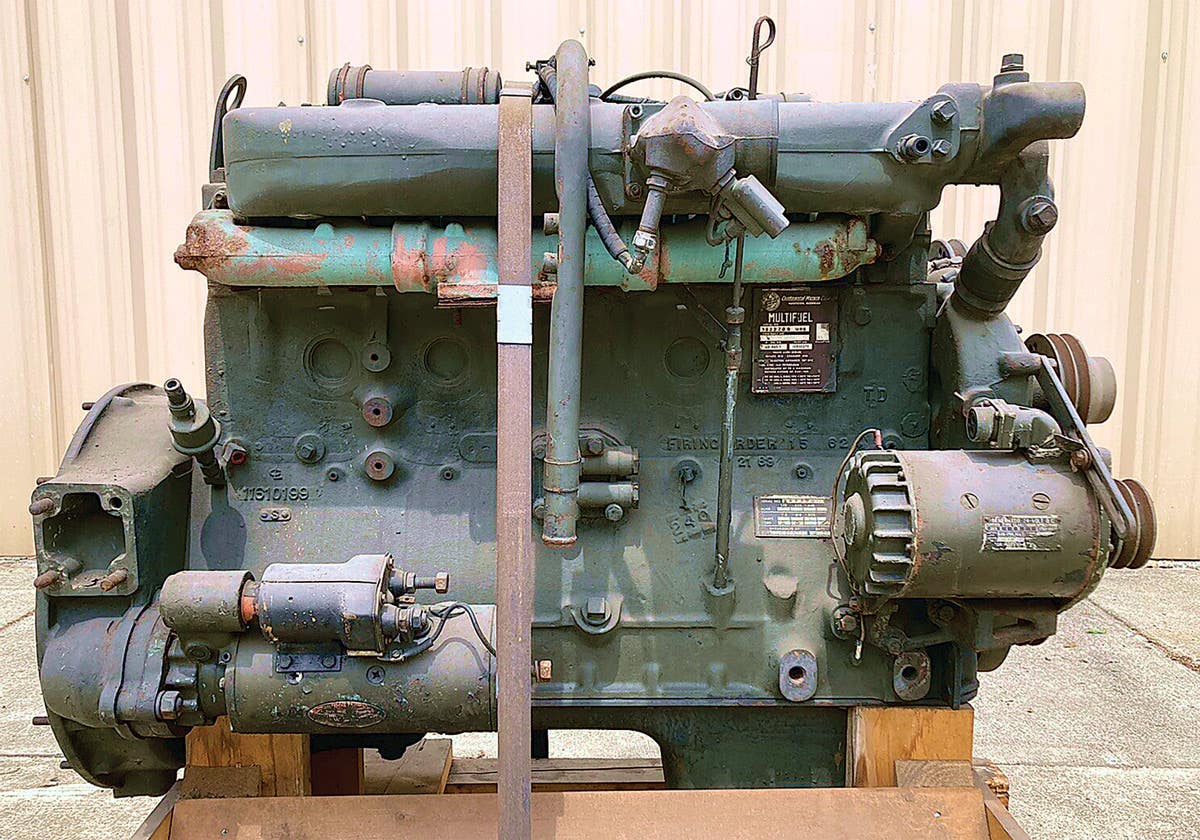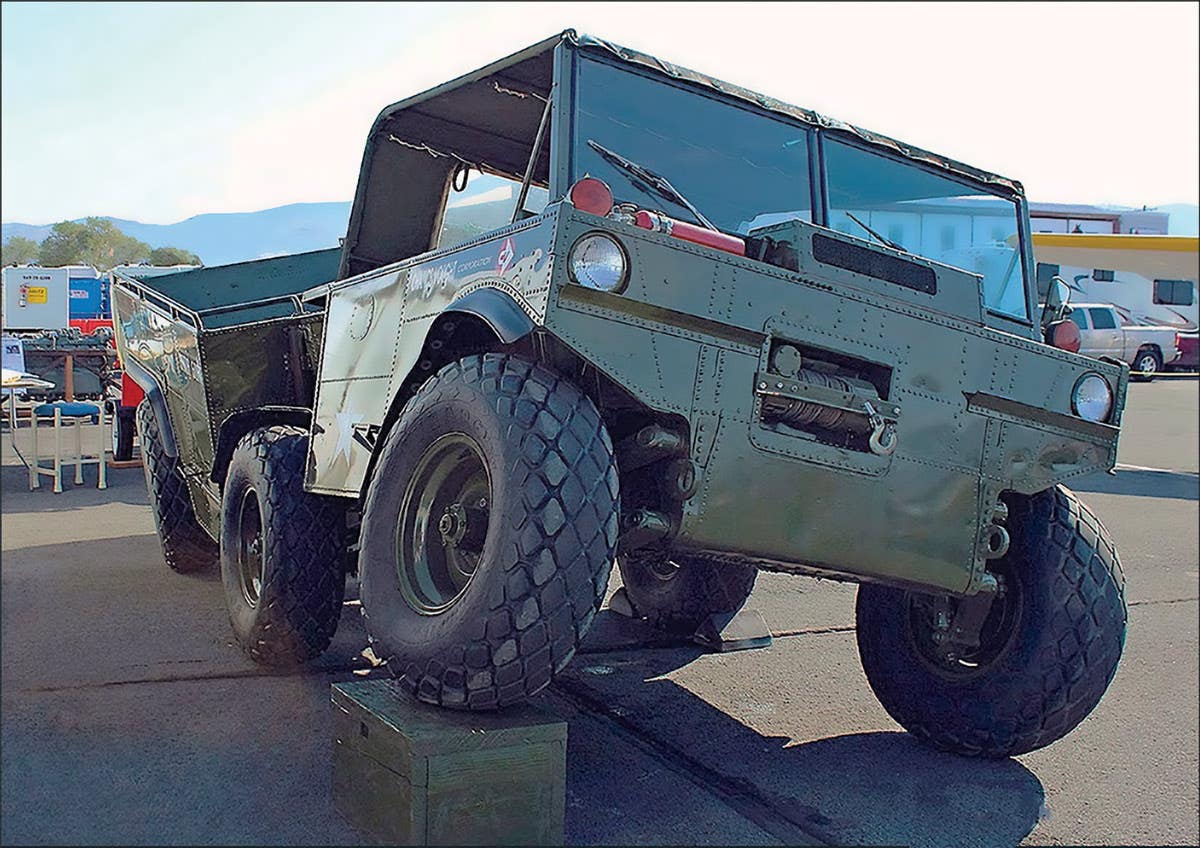Military Vehicles of a Different Color
Not all military vehicles are ‘olive drab’
by Victor Wells
We all love the Jeeps, M37s, deuce-and-a-half’s, and tanks — all of which are universally painted some shade of olive drab (OD). What a person might not realize is that all of these OD trucks and tracks are considered to be “tactical vehicles.” That means these vehicles were designed for rugged use on- and off-road in combat or tactical use. That is why they were painted in the drab green colors.
However, there was a whole other class of vehicles used to support the military in their day-to-day operations at installations and depots during the post-WWII Cold War era. These were referred to as “administrative vehicles.” Whereas tactical vehicles underwent long periods of development and testing before reaching production, administrative vehicles were commercial and “off-the-self.” They were usually very basic with no frills. The most commonly encountered were sedans, pick-up trucks, vans, stake- bed trucks, dump trucks, tractors, and even construction vehicles.
Usually, the only obvious indication of military use of one of these administrative vehicles was its paint job: Usually gray for Navy, blue for Air Force, forest green for Marines, or olive drab (usually glossy) for Army. And, even though it would have made sense to standardize the fleet with one particular make or model, Congress (under pressure from the automotive industry) required that the services purchase from all of the major suppliers in the interest of “fairness.”
So, on any given military installation, there would be large numbers of vehicles ranging from Chrysler, General Motors, Ford, American Motors, or International, as well as the large trucks from Mack, FWD, etc. Most were basic commercial vehicles. On some, there were some simple factory modifications or additions to better meet the mission requirements of the services. Some basic additions that were common included brush guards, pintle hooks, trailer hitches, and oversize wheels.
MILITARY VEHICLES COME IN ALL COLORS
There are many of us who served in the military who had more experience with these administrative vehicles then with tactical vehicles. As a Marine 0311 (or “Grunt”), I didn’t get to drive any tactical vehicles. I rode in the occasional M151 or 6x6. Usually, I walked.
When I came back from Vietnam, I was surprised to be assigned to Marine Corp Air Station (MCAS) Cherry Point, North Carolina. During my leave, I spent most of my time searching for a good pick-up truck and a camper to buy with the money I had saved during my time in Vietnam. I finally located a 1967 Ford F100 with 352 engine and three-speed manual transmission with column shift, (“three on the tree”). Days later, I found an 8-foot slide-in camper called a “Huntsman” to go on it.
I had no trouble driving this truck. When I was in high school, my father had bought a 1964 Ford Fairlaine with “three on the tree.” I learned to drive it and how to unlock the linkage that would seize up.
Later, the first vehicle I bought myself was a 1953 Jeep pick-up with a three-speed on the floor. So, I used stick shifts all through high school.
When I arrived at MCAS Cherry Point, I did not know what I would be doing since I was a Grunt and this was an Air Station. When I reported in at the personnel office for assignment, I overheard that they were short of brig guards and military police. When I got to the assigning officer, he said, “What are we going to do with you?” I did not want to work in the jail, so I quickly spoke up and said, “The Major over there said they were short of MP drivers.” So, I became an MP.
When I reported to the Provost Marshall Office (PMO), the first thing I noticed were the vehicles parked there. They were not painted Marine Corps green, but, rather, Navy grey and marked “U.S. Navy” with the usual “For Official Use Only.” These were early to mid-sixties pick-ups: one Dodge and a couple of Fords and Chevys. There were some sedans, but they were for the officers. We troops had to use the pick-ups.
After I reported in, I learned I was correct in thinking that they needed drivers. In those days, you had to have a military-issued driver’s license to drive even administer vehicles. The first thing they did was to send me to driver’s training. They filled out some paperwork and gave me a map to the motor pool and told me not to come back until I had a military drivers license.
I followed the map to the motor pool and entered the old wooden building there. Inside, there were four civilian workers who looked at me like I was disturbing them. One asked what I was doing there, so I showed him my paperwork and told him I was there to take the drivers training. He kind of shook his head and groaned and asked “I don’t suppose you can drive a stick shift?”
I pointed out the window and said “See that Ford with the camper on it? That’s mine and it’s a three on the tree.”
He shrugged and took my papers. He told me, “We will have you take the driver’s test and see how you do.” We went out the back of the building and walked to an old Ford pick-up (much like the ones I saw at the PMO).
We got in, and I drove a course outlined by orange traffic cones. I drove around, up and down, and forward and backwards. After some parallel parking, it was back to the back to the start line. I did not kill anybody or run over any cones, so I figured I did alright.
We went back into the building and the tester disappeared into a back office. While I waited, I asked the other men there how long the class lasted. They said it could be a week or two depending on how many were in the class and their abilities.
When the man came out of the office, I asked when the class would start. He said, “It doesn’t.” He handed me my papers that were stamped, “Passed,” and a wallet-size driver’s license card.
I went back to the PMO office and checked in. They said, “What are you doing back here?” I replied, “You said come back when I had my license.” I gave them my papers and showed them my license. They gave me dumb looks.
The down-side of this was, as a driver, I had the work a lot of extra shifts and double shifts when we were short drivers or needed all trucks on the road. Since I could drive all of the trucks we had, I often got the oldest junkers.
Once, I had to do an emergency run across the base in second gear because I did not have time to stop and un-jam the linkage in an old Ford. Another time, I was dispatched to a barracks where a Marine was having seizures. An ambulance was dispatched, but only one Corpsman — the driver. The Corpsman said he needed to be in the back with the patient and asked if anyone was licensed to drive an emergency vehicle. I said, “I am an MP, so who is going to say anything if I drive?” I drove the ambulance with lights and siren to the hospital. If I recall correctly, it was a stretched Pontiac.
AN OLD MARINE LOOKS AROUND THE HOBBY
In January 2019, I attended the Arizona Military Vehicle Collector Show in Tempe, Arizona. There, in the shade of all that OD iron, was a 1965 short-bed, step-side, half-ton Ford pick-up with a shiny new Navy gray paint job. There were no markings on it. The sign on the window indicated that it was ex-Navy. It was the image of the trucks I drove as an MP — except it was far better looking with a fresh paint job. I was pleased to see how much attention it got in comparison to all the olive drab vehicles at the show.
This brings me to my current project. I have been working on a M38A1 for some time, but I wanted an older pick-up that would be simple and easy to work on. I decided I wanted an old Jeep pick-up like I had in high school or an old Dodge Power Wagon.
I spend two to three years looking and came close twice to buying a Jeep pick-up before the deals fell through. Finally, while looking at a Power Wagon web site, I spotted a 1964 W300 Power Wagon with a flat bed up in Montana. What made it more interesting was that it was an ex-Air Force telephone repair truck. It was still in Air Force blue with the markings on the doors!
I made some calls to get information on it and wanted to go up to see it, but it was the middle of winter. I tried to go see it in February, but hit snow in Wyoming and had to turn back.
It was May before I had a chance to go see it. I drove it around the man’s ranch and up and down his mile-long drive way. It rattled and shook and reminded me of a WC-53 I drove from Ohio to Texas a long time ago. One thing I realized was that I was not going to try to drive it back home to Colorado! It needed lots of work, but most of the things I could do.
The dash board instrument panel on this truck is interesting. It is not the civilian-style but has all military-style, round gauges. The round speedometer is just like a Jeep and only goes to 60 MPH.
The main issues with the truck were the missing utility bed, winch, and brush guard. I returned home to think it over and continued to have discussions with the owner about the truck. I told him I did not want the bed that was on it. It was oversized and not right for the truck. He said he would be happy to take it off. He could use it on something else. Then he said he could check with the rancher he bought the truck from to see if any parts were still at the ranch. When he called back some time later, he informed me that they were not able to find the bed or the winch, but they did discover the brush guard hanging in the barn.
I thought I could do without the winch. I could look for one in the future. I had leads on some possible beds that would fit this truck’s nine foot frame. I was glad they found the brush guard, since I did not know were I might get one and do not have the skill or equipment to make one. In fact, finding the brush guard may have convinced me to buy the Power Wagon,.
I made an offer, and it was accepted. Now, I had to decide how to get it home. I considered using a tow bar or renting a trailer, but I had doubts about my truck’s ability to tow the weight.
I tried some of the online transportation companies, but that opened a whole can of worms. I learned that the bids I received were not worth the air they were spoken with. Most companies did not want to go so far off of the main Interstate highway to pick up this truck. I had calculated the cost of me going up to get the truck, so I could compare to the cost of having it hauled, but most bids were too high.
I finally found an individual who was willing to get it, but the price was still higher then my estimate for me to haul it. Regardless, I felt it was safer to have it shipped. This cost was not in my budget, but if I was to buy it I had to get it home.
While waiting, there was still the problem of a bed to address. I had been talking to a man n Texas who had a nine-foot utility bed from a government truck. After some discussion, he decided he wanted to keep it. I saw a nine-foot Dodge step-side bed in California, but it sold fast.
I had always had a plan “B” in mind. A couple of years ago, I spotted a military steel bed in a junk yard on the other side of the county. I stopped in and asked if I take measurements. It was nine feet long. I determined it was probably off a Chevy G-506 one-and-a-half-ton truck. He gave me a price that I felt was not unreasonable.
So, I had a line on a bed to finish the truck. Now I had to get the truck ready to receive the bed.
I spent the summer preparing the truck to get it licensed and ready to mount the bed. The brakes were first, with a new master cylinder and one wheel cylinder. I sanded and wire-wheeled the frame to prime and paint it in preparation for mounting the bed.
I took the seat out to work on the interior of the cab. The main issue was the transmission cover. It was held on by just two bolts. I removed it and cleaned off all the oil and grease before priming and painting it. If found the clips that allowed me to attach the cover in place with all twelve bolts. This really cut down on a lot of the cab noise!
I had a new exhaust system installed along with a new alternator and voltage regulator. Four new 900x16 tires would guarantee a smooth, safe ride. Before installing the bed, I painted the cab and front end in Air Force strata blue, being careful not to cover over the original Air Force markings.
Finally, in September 2018, I was ready to drive it the sixty five or so miles across the county to install the bed. I had some trouble on the way over. I thought I had flushed out the gas tank but, when I filled up the tank on the way out of town, it broke loose lots of rust that kept clogging my fuel filters. When I finally arrived at the junk yard, the first thing I had to do was remove a gas tank someone had mounted under the bed, then take off a couple of pieces that would have punctured my fuel tanks. To do this required me to cut off a couple of bolts. It was a very hot day and I came close to heat exhaustion requiring me to go into the yard office and sit in front of the air conditioner and drink lots of water!
With the bed stripped, they lifted it up with a lift bucket and placed it on my truck’s frame rails — a perfect fit! I bolted it in place with the brackets I had made. By late afternoon, it was finished, and I was ready to head for home.
Once home, I pulled into a car wash and washed all the mud and wasp nests out of the bed to get it clean ready for painting. I had a week to paint it and get it ready for a small car show that some members of our military vehicle club were going to attend.
It felt good to drive the Power Wagon to a show to display it. It stood out next to the MB Jeeps. It was unique: half military and half civilian.
As I was preparing to leave at the end of the show, a man came up to me and said he just arrived. The first thing he saw was my truck standing out of the crowd. He said he had to see it first because he liked “real trucks.” I replied, “Yes. This is a real truck, all truck, and nothing but truck.” It’s funny how there is usually that one visitor that makes all the work worth while!
So what is important about saving some of these “boring” administrative vehicles? Because there aren’t any more of them.
Some years ago, the military lost their ability to purchase their own administrative vehicles. The General Administrative Services (GSA) that had bought vehicles for other government agencies, took over supplying administrative vehicles to the military, as well. Now, if any of the services need a sedan, van, or truck, they order them from GSA. They can get any color they want as long as it is white. They are prohibited from adding any markings or decals. They keep the vehicle for about three years, and then turn them in for a replacement. GSA sells the used vehicles on the commercial market. This is supposed to be a great savings for the government.
Of course, there are exceptions. If the ordering service has a special need, they can get a waiver from GSA to buy special vehicles. It is hard to do, however.
I am happy to have my ex-Air Force Dodge Power Wagon and am looking forward to equipping the truck properly. I am sure it probably had a spotlight on the roof and a yellow flashing light on the cab.
One last thing about colors: I remember some flight line vehicles were bright yellow with red markings. In addition, fire, crash, and emergency vehicles were often red with some being white or chartreuse — some were even yellow or black. So, keep in mind: There is some room for some color in this hobby of ours!
You may also enjoy
*As an Amazon Associate, Military Trader / Military Vehicles earns from qualifying purchases.
From the staff of North America's no. 1 historic military vehicle source -- Military Vehicles Magazine







